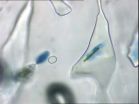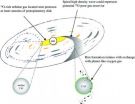(Press-News.org) Sea-ice algae – the important first rung of the food web each spring in places like the Arctic Ocean – can engineer ice to its advantage, according to the first published findings about this ability.
The same gel-like mucus secreted by sea-ice algae as a kind of antifreeze against temperatures well below minus 10 C is also allowing algae to sculpt microscopic channels and pores in ice that are hospitable to itself and other microorganisms.
Altering ice to their benefit should help sea-ice algae adapt to a warming world, which is good news for hungry fish and shellfish farther up the food web, but what it means for the integrity of the ice itself raises unanswered questions according to Jody Deming, University of Washington professor of oceanography and co-author of a paper appearing in the March 1 Proceedings of the National Academy of Sciences.
Ice riddled with more channels and pores will be weaker, yet such openings plugged with algal secretions actually hold more salty water and thus may slow melting in the spring and summer, she says. Scientists have yet to determine if the two processes cancel each other or if one will dominate, say Deming and co-authors Christopher Krembs, Washington State Department of Ecology, and Hajo Eicken, University of Alaska Fairbanks.
Sea ice is home to microscopic plants and animals, bacteria and viruses that stay alive in brine-filled openings in the ice. The gel-like mucus secreted by ice algae and other microorganisms, called extracellular polysaccharide substances, consists of complex sugar compounds. The mucus depresses the freezing point and keeps pore spaces in ice filled with at least some liquid.
The researchers focused on the algae that dominate the sea-ice biota across the Arctic each spring and in particular the variety Melosira arctica. Individually, Melosira arctica are about 50 micrometers long, or the width of a strand of human hair. Joined together, however, they form filaments that are meters long. Under-ice divers witness great forests of the algae hanging underwater from the sea ice each spring, Deming says.
Once considered minor contributors to the food web, sea-ice algae are gaining respect, Deming says. They bloom first in the spring and are responsible for nearly 60 percent of the primary production in ice-covered water at that time of year. As ice melts, creating open water, other microorganisms come to dominate primary production but Melosira arctica and brethren get credit for kick-starting the growing season.
Faced with a warming world, some scientists speculate that the importance of sea-ice algae, even in the spring, will diminish.
That may not be the case according to the new findings. In lab work, for instance, Deming and her co-authors found mucus from ice algae increased ice salinity by up to 59 percent and increased the number and complexity of channels. That means more places in the ice for algae to live where they can receive sunlight and avoid being eaten. The channels also retain more iron, nutrients and carbon dioxide needed for algal growth.
"Sea-ice primary productivity is expected to increase in a warming climate until the nutrient supply from below becomes limiting," the PNAS paper says. The work was funded by the National Science Foundation.
INFORMATION:
For more information:
Deming, 206-543-0845, jdeming@u.washington.edu
Websites
PNAS abstract
http://www.pnas.org/content/108/9/3653
Deming website
http://www.ocean.washington.edu/people/faculty/deming/
Eicken website
http://seaice.alaska.edu/gi/people/eicken
Sea ice background
http://www.actionbioscience.org/newfrontiers/deming.html
Algal antifreeze makes inroads into ice
2011-03-04
ELSE PRESS RELEASES FROM THIS DATE:
Fraser Yachts Announce New Yacht Listings for Charter
2011-03-04
Fraser Yachts is pleased to announce the following charters available for Mediterranean yacht charter and Caribbean yacht charter for 2011/12. M/Y Pamela V yacht is a luxurious 45.9m Hakvoort built yacht, available for yacht charter in the Bahamas and the British Virgin Islands. During the high season, it will be available for $235,000 per week and in the low season will go down to $220,000. Currently located in the Caribbean, this luxury yacht is due to be completed later this year. With the ability to sleep 8 guests in 4 staterooms, and 10 crew members, you can expect ...
In search of cancer's common ground: A next-generation view
2011-03-04
Researchers have synthesized the vast literature on cancer to produce a next-generation view of the features that are shared amongst all cancer cells. These hallmarks of the disease provide a comprehensive and cohesive foundation for the field that will influence biomedical researchers in their quest for new cancer treatments.
The review article by Douglas Hanahan of École Polytechnique Fédérale in Switzerland and Robert Weinberg of the Whitehead Institute for Biomedical Research appears in the March 4th issue of Cell, a Cell Press publication. The new article updates ...
Kidney transplant recipients: Get moving to save your life
2011-03-04
Low physical activity increases kidney transplant patients' likelihood of dying early, according to a study appearing in an upcoming issue of the Clinical Journal of the American Society Nephrology (CJASN). The results suggest that patients need to exercise to fend off an early death.
Inactive people in general face increased risks of developing cardiovascular disease and of dying prematurely. Individuals with chronic kidney disease—particularly those on dialysis—tend to get little exercise, but most increase their activity levels modestly after receiving a kidney transplant. ...
California islands give up evidence of early seafaring
2011-03-04
Evidence for a diversified sea-based economy among North American inhabitants dating from 12,200 to 11,400 years ago is emerging from three sites on California's Channel Islands.
Reporting in the March 4 issue of Science, a 15-member team led by University of Oregon and Smithsonian Institution scholars describes the discovery of scores of stemmed projectile points and crescents dating to that time period. The artifacts are associated with the remains of shellfish, seals, geese, cormorants and fish.
Funded primarily by grants from the National Science Foundation, the ...
Fossils of horse teeth indicate 'you are what you eat,' according to NYCOM researchers
2011-03-04
Old Westbury, New York (Mar. 3, 2011) – Fossil records verify a long-standing theory that horses evolved through natural selection, according to groundbreaking research by two anatomy professors at New York College of Osteopathic Medicine (NYCOM) of New York Institute of Technology.
Working with colleagues from Massachusetts and Spain, Matthew Mihlbachler, Ph.D., and Nikos Solounias, Ph.D. arrived at the conclusion after examining the teeth of 6,500 fossil horses representing 222 different populations of more than 70 extinct horse species. The records, spanning the past ...
Optical tweezers software now available for the iPad
2011-03-04
Optics researchers from the Universities of Glasgow and Bristol have developed an iPad application for accurate, easy and intuitive use of optical tweezers.
Optical tweezers, used to manipulate tiny particles through the use of highly focused laser beams, are the tool at the heart of much molecular biology – helping us to experiment with and better understand the microscopic processes of organisms.
Research published today, Friday 4 March 2011, in IOP Publishing's Journal of Optics, shows how a team of researchers has overcome the limitations of computer mouse and ...
Johns Hopkins team explores PARIS; finds a key to Parkinson's
2011-03-04
Johns Hopkins scientists have discovered that PARIS — the protein — facilitates the most common form of Parkinson's disease (PD), which affects about 1 million older Americans. The findings of their study, published March 4 in Cell, could lead to important new targets for treatment.
Previous research has shown that a protein dubbed parkin protects brain cells by "tagging" certain toxic elements for natural destruction. Mutations in the parkin gene cause rare forms of PD that run in families, but its role remained unclear in sporadic late-onset PD, the prevalence of which ...
Star-shaped brain cells feed long-term memory
2011-03-04
Star-shaped cells in our brains called astrocytes were once considered little more than structures to fill the gaps between all-important neurons. But more recent evidence has emerged to reveal that those astrocytes play more than a supporting role; they are involved in information processing and signal transmission and they help to regulate the shapes of our neurons and their connections to one another.
Now, researchers reporting in the March 4th Cell, a Cell Press publication, have found that astrocytes are also essential for making long-term memories. When they don't ...
Oxygen isotope analysis tells of the wandering life of a dust grain 4.5 billion years ago
2011-03-04
Scientists have performed a micro-probe analysis of the core and outer layers of a pea-sized piece of a meteorite some 4.57 billion years old to reconstruct the history of its formation, providing the first evidence that dust particles like this one experienced wildly varying environments during the planet-forming years of our solar system.
The researchers interpret these findings as evidence that dust grains traveled over large distances as the swirling protoplanetary nebula condensed into planets. The single dust grain they studied appears to have formed in the hot ...
Trouble with the latest dance move? GABA might be to blame
2011-03-04
If you tend to have trouble picking up the latest dance moves or learning to play a new piano piece, there might be an explanation. A new study published online on March 3rd in Current Biology, a Cell Press publication, shows that people who are fast to learn a simple sequence of finger motions are also those whose brains show large changes in a particular chemical messenger following electrical stimulation.
That chemical messenger, known as GABA, is important for the plasticity of the motor cortex, a brain region involved in planning, control, and execution of voluntary ...



